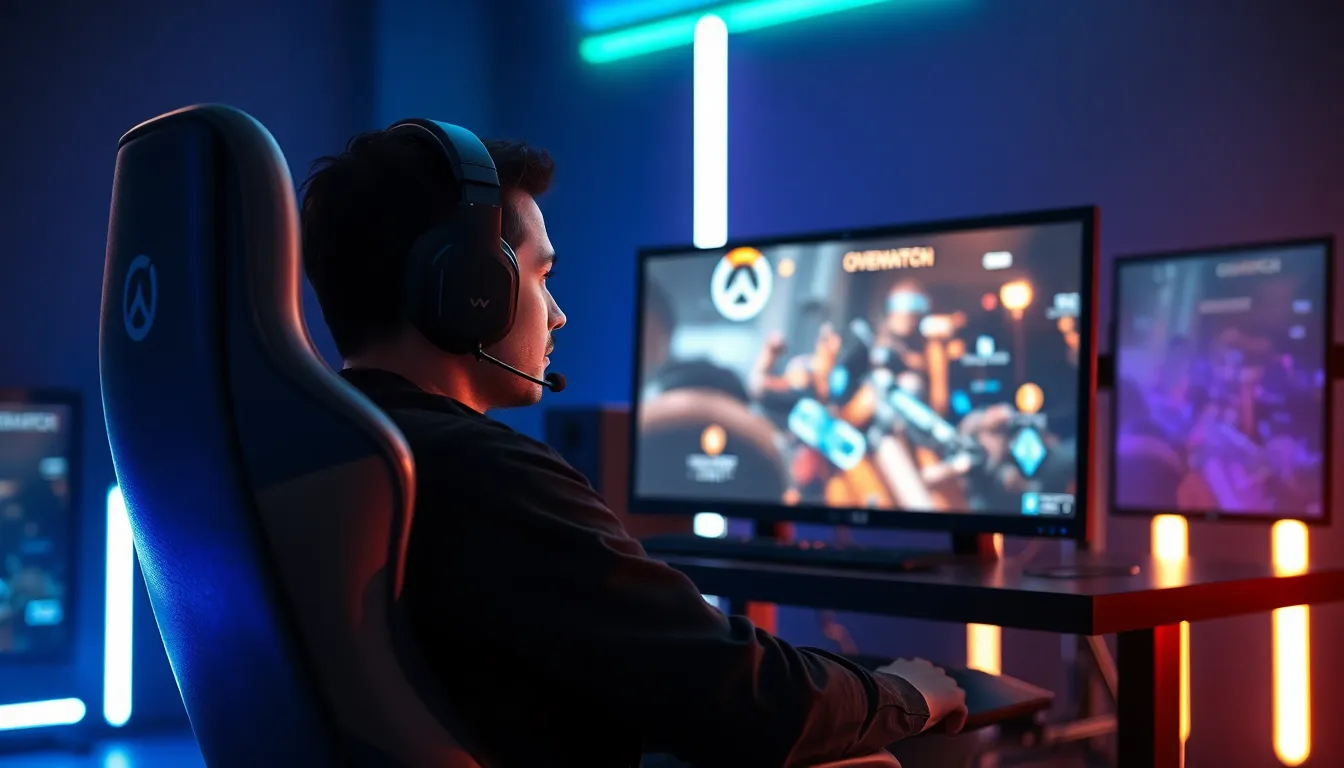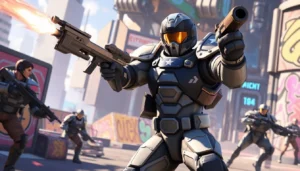Table of Contents
ToggleIn the fast-paced world of Overwatch, climbing the ranked ladder can feel like trying to scale Mount Everest in flip-flops. With countless heroes, strategies, and the occasional rogue teammate, it’s easy to get lost in the chaos. But fear not! This guide is here to turn your ranked woes into victories, one headshot at a time.
Understanding Overwatch Ranks
Overwatch features a competitive ranking system that helps players gauge their skill levels and progress. Understanding ranks is essential for effective climbing.
Rank Tiers Explained
Rank tiers range from Bronze to Grandmaster, each tier reflecting specific skill levels. Players start at Bronze and can progress through Silver, Gold, Platinum, Diamond, Master, and Grandmaster. Each division within the tiers adds an extra layer, such as Gold 1 to Gold 5. A player’s matchmaking rating (MMR) drives rank placement, determining skill-based matchmaking. Achieving higher ranks demands consistent performances and mastery of heroes. Analytics show that players in higher ranks demonstrate superior teamwork, communication, and game sense.
Importance of Competitive Play
Engaging in competitive play enhances individual skills and fosters teamwork. Competitive matches often yield better rewards, including endorsements and credits for skins. Players face opponents of similar skills, ensuring balanced games. Adapting to higher competition levels cultivates adaptability and strategic thinking. Developing these skills proves crucial not only for individual growth but also for team synergy. Tracking progress through competitive play assists in identifying strengths and weaknesses, guiding improvement strategies effectively.
Preparing for Ranked Climbing

Preparing effectively can significantly enhance performance in Ranked Overwatch matches. Key aspects include hero selection and optimizing game settings.
Selecting the Right Hero
Selecting the right hero influences success in matches. Players should consider their strengths and comfort levels with various roles. Understanding team composition enhances synergy during gameplay. For instance, a balanced team comprises damage dealers, tanks, and healers. Choosing heroes based on the current meta can provide an advantage. Players often benefit from mastering two to three heroes in each role. This versatility allows for adaptability in team compositions and counter-picking. Familiarity with several heroes aids in overcoming challenges posed by specific opponents. Knowing the strengths and weaknesses of chosen heroes is crucial for maximizing impact in matches.
Optimizing Your Settings
Optimizing game settings affects overall performance. Start by adjusting sensitivity levels to improve aim precision. Many players find comfort in lower sensitivity for better control. Keybindings typically require customization to enhance reaction times. Setting up accessibility options can improve gameplay experience. Graphical settings should prioritize a balance between visual quality and performance for smoother gameplay. Reducing input lag also helps in competitive play. Players often adjust the field of view to gain a wider perspective of the battlefield. Streamlining settings minimizes distractions, allowing for better focus on in-game actions.
In-Game Strategies
Effective in-game strategies can significantly impact success in ranked play within Overwatch. Key elements include communication, teamwork, positioning, and map awareness.
Communication and Teamwork
Clear communication remains essential for team coordination. Players should use voice chat or text to relay critical information, like enemy locations or ultimate status. Engaging fellow teammates encourages synergy, fostering effective strategies and counterplays. Recognizing each player’s role strengthens teamwork. A cohesive unit performs better, as players can anticipate each other’s moves. Celebrating small victories builds morale, enhancing the overall gameplay experience. Prioritizing objectives over individual achievements also contributes to winning matches.
Positioning and Map Awareness
Strategic positioning profoundly influences survivability and effectiveness during matches. Players must maintain awareness of map layouts and identify advantageous spots for their heroes. Utilizing high ground typically offers better sightlines, while maintaining cover minimizes exposure to enemy fire. Observing spawn locations assists in anticipating enemy movements. Learning key choke points enables players to control engagements effectively. Each map features unique elements to exploit; players should familiarize themselves with all map nuances for optimal performance. Staying aware of teammates’ positions promotes coordinated attacks and defense, ultimately leading to greater success in ranked play.
Improving Your Skills
Enhancing skills in Overwatch is crucial for climbing the ranked ladder. Focusing on specific areas of gameplay can lead to significant improvements.
Aim and Mechanics
Precision plays a key role in Overwatch. Players benefit from practicing their aim regularly, which enhances their ability to hit targets consistently. Utilizing aim trainers, such as Aim Lab or Kovaak’s, can develop muscle memory. Focusing on headshots increases damage output and helps secure eliminations faster. Additionally, understanding weapon mechanics contributes to better performance. Players must learn recoil patterns and shot timings for their chosen heroes. Lastly, varying sensitivity settings in practice leads to optimal control during engagements.
Game Sense and Decision Making
Game sense significantly impacts gameplay outcomes. Players should invest time observing enemy movements and predicting their actions. Knowing when to engage or retreat can prove crucial during intense battles. Continuously assessing the situation allows players to make informed decisions, enhancing overall effectiveness. Analyzing replay footage helps identify mistakes and areas for improvement. Understanding ultimate economy benefits teams during critical moments. Finally, anticipating teammates’ needs fosters synergy and promotes positioning that maximizes team success.
Maintaining a Positive Mindset
A positive mindset plays a vital role in climbing the Overwatch ranked ladder. Fostering resilience helps players overcome the inevitable challenges they face during their journey.
Handling Losses and Frustration
Handling losses and frustration requires effective coping strategies. Acknowledge setbacks as opportunities for growth. Players can analyze mistakes to identify areas for improvement after a defeat. Focusing on specific elements, like teamwork and communication, improves future performance. Establishing a routine for reviewing gameplay can alleviate frustration as well. By staying calm and reframing thoughts, players maintain momentum and motivation for their next matches.
Staying Motivated During the Climb
Staying motivated during the climb demands a commitment to self-improvement. Setting small, achievable goals keeps focus sharp. Players benefit from tracking progress, which can reveal improvements over time. Engaging with positive communities fosters encouragement and support as well. Celebrating personal milestones, such as mastering a new hero or achieving a high number of eliminations, enhances motivation. Cultivating an optimistic outlook turns challenges into stepping stones toward success in ranked play.
Climbing the ranked ladder in Overwatch is a journey filled with challenges and opportunities for growth. By focusing on key strategies such as hero mastery, effective communication, and maintaining a positive mindset, players can enhance their performance and achieve their desired ranks.
Utilizing game settings and understanding map dynamics further empowers players to make informed decisions during matches. Embracing the learning process and celebrating small victories keeps motivation high, transforming setbacks into valuable lessons.
With dedication and the right approach, players can navigate the complexities of Overwatch and find success in their ranked climb.




